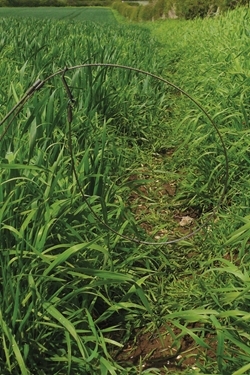Contents
Introduction
 Although snares are an ancient hunting tool, their use to catch canids (dog-like animals) wasn’t really possible until the first widespread availability, early in the 20th Century, of small diameter flexible steel cable, manufactured for bicycles, aeroplanes, etc. Earlier materials, such as cordage or brass wire, were easily shredded by the teeth of any canid. So it is a mistake to imagine that snaring foxes is a traditional practice perfected over centuries. Furthermore, the use of snares is subject to human legislation as well as natural laws. That legislation reflects the values of society for both conservation and animal welfare. Our experience shows that from both perspectives – efficient practice and the wider interests of society – both the snare itself (the hardware) and the way it is used (operator practice) leave room for improvement. By all means learn from the way others have used snares previously; but remember that you are using them in the 21st Century.
Although snares are an ancient hunting tool, their use to catch canids (dog-like animals) wasn’t really possible until the first widespread availability, early in the 20th Century, of small diameter flexible steel cable, manufactured for bicycles, aeroplanes, etc. Earlier materials, such as cordage or brass wire, were easily shredded by the teeth of any canid. So it is a mistake to imagine that snaring foxes is a traditional practice perfected over centuries. Furthermore, the use of snares is subject to human legislation as well as natural laws. That legislation reflects the values of society for both conservation and animal welfare. Our experience shows that from both perspectives – efficient practice and the wider interests of society – both the snare itself (the hardware) and the way it is used (operator practice) leave room for improvement. By all means learn from the way others have used snares previously; but remember that you are using them in the 21st Century.
Fox snares are an imperfect tool. They have the potential to catch non-target species, and to cause tremendous suffering in captured and escaping animals. This does not make them bad. Motor cars have a comparable capacity to cause suffering and damage, and harmful side effects, but can nevertheless be used to an acceptable standard. The key is responsible, careful use. This advice is primarily intended to help you use snares in a focused and effective way, and to point out working practices that are likely to result in poor outcomes. Our advice draws on two sources: first-hand experience of the authors from the mid-1980s to the present day, and extensive studies involving scores of gamekeepers who volunteered their help for 12 months at a time during the last 15 years.
Increasingly, legislation regulates what you may and may not do with snares. Some of this regulation is logical and straightforward, some is difficult to interpret or illogical. Nevertheless, it’s crucial for all snare users to know and follow the law, because if the regulation is widely perceived to be flouted there will be a strong argument to outlaw snares altogether. In Scotland the passing of the Wildlife and Environment (Scotland) Act 2011 placed a legal obligation for all snare users to become accredited, with the implication that sanctions can be imposed on those who break the legal conditions, just as they are with driving licences. In this leaflet we explain the legal requirements, but our real aim is to give you practical advice that will improve your use of snares from all points of view. We want fox snares to be used with professional care and responsibility.
Why snares are considered important
Snares are particularly a tool of spring and summer when other methods of fox control become impractical because of the growth of vegetation cover, especially among arable crops. The breeding season of foxes coincides, naturally enough, with that of their prey. The food demands of growing cubs are far greater than the maintenance requirements of adults. So to protect prey species that are especially vulnerable to fox predation, like ground-nesting birds, fox control in spring and summer is crucial.
In the UK, the only other legal methods for fox control involve processes of which the fox is fully aware (e.g. drives to standing guns, lamping, attraction to a scent lure, flushing/digging-out at the cubbing earth). With these methods we can expect there to be a selection pressure against the naive or bold fox and in favour of the wary fox. The naive members of the population are the young ones. By the time a fox has survived its first winter and reached breeding age, it has learned a thing or two and is harder to catch or shoot. To control numbers in spring and summer, you need to catch the animals of breeding age. So snares are considered not to have any functional replacement, but they have their problems, which makes them controversial.
✓ Fox control: Is it important?
✓ What are the alternatives to snaring?
✓ The main components of a well-designed snare
✓ Fox snares: Hardware vs practice✓ Key controversies
Download Free Guide >